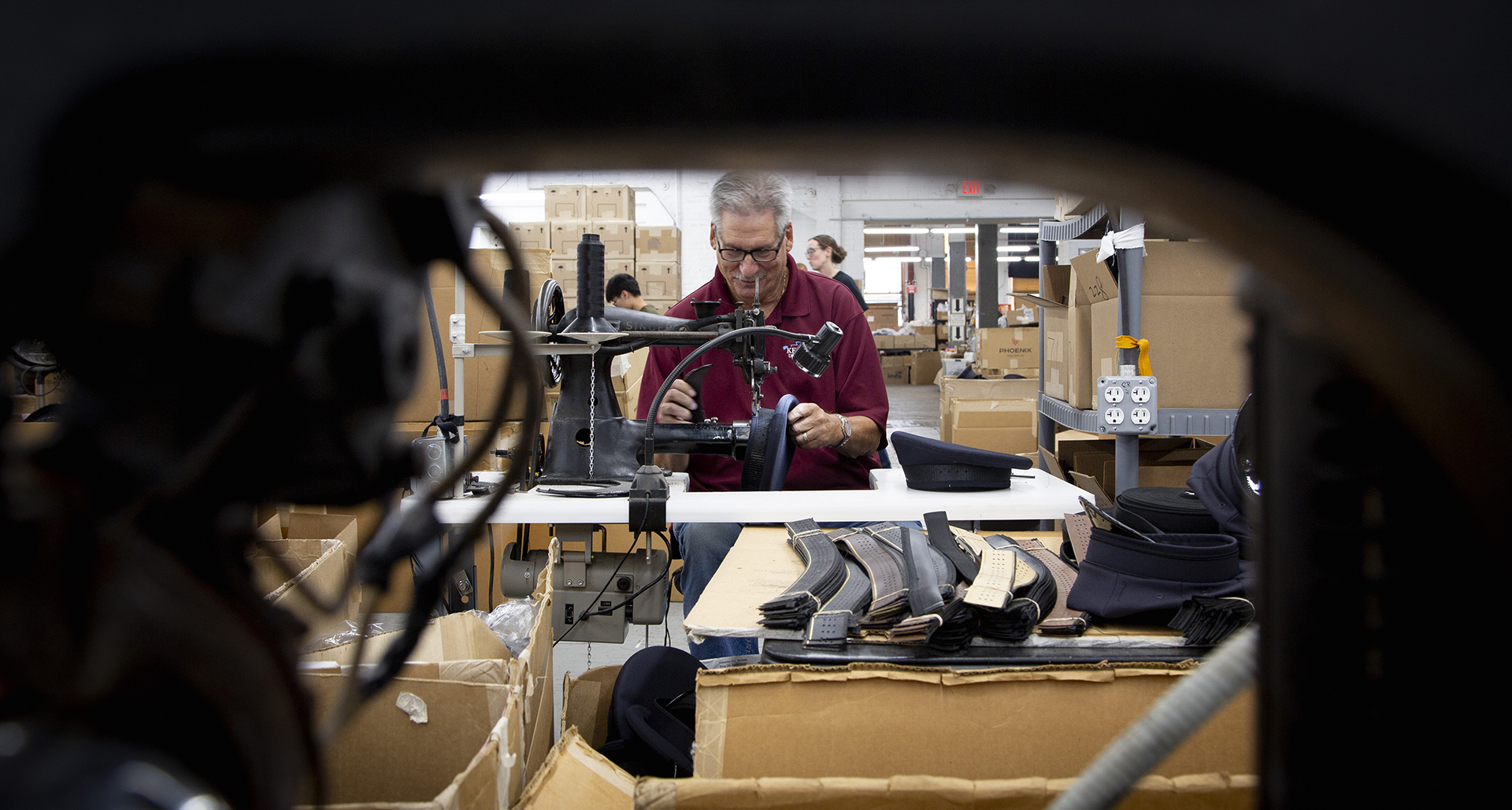
Family-owned U.S. business has been making American Legion covers for over a century.
The iron-black Singer 43/7 occupies a humble place of distinction in the middle of the embroidery-side floor. “It’s mine,” says Neal Susten, co-owner of Keystone Uniform Cap Co. in Philadelphia. “Nobody else can use it but me. It was my grandfather’s. It’s a great machine. It never breaks.”
At 70, Neal still commonly scoots up to the sturdy old sewing machine and goes to work, stitching alongside his employees. His father, Samuel, did likewise at the exact same machine for some 40 years. And before that his grandfather, M.H. Grossman, who started the company in 1918 after immigrating to the United States, toiled behind the venerable Singer, producing headwear for train porters, bellmen, firefighters, police officers, prison guards, veterans organizations and others, for decades.
In 1997, M.H. Grossman, Inc., merged with former competitor Keystone Uniform Cap, also of Philadelphia, and Neal entered a partnership with David Selvin, a multigeneration maker of uniform caps himself. “It’s been a great partnership,” Neal says, noting that the united effort has increased production – serving more than 100 organizations and agencies – and added jobs as well, from 27 to nearly 50 since the merger. It is one of only a handful of U.S. companies that manufacture uniform caps for police and firefighters, and the only company that produces American Legion covers.
And, says Neal: “We’re just getting stronger over the years. We have an obligation to fulfill.”
His 33-year-old son, Brian, a supervisor on the embroidery side, represents the fourth generation. The youngest cap maker in the Grossman lineage takes pride in the fact that Keystone covers are worn by men and women who serve their communities and nation in uniform.
“These caps mean a lot to a veteran or a police officer,” says Brian, a former American Legion Baseball player and father of three. “Some of these veterans are buried with these caps on their heads. It’s definitely something special.”
“It’s a great privilege to manufacture caps for veterans who have given so much to our country,” adds Neal, whose operation takes up nearly 35,000 square feet on three factory floors. “The pride we have – plus all our employees have – is something we do on a daily basis.”
Keystone makes more than 11,000 American Legion Family covers a year. Brian receives between 40 and 200 orders a day from Emblem Sales in Indianapolis, and shipments go out promptly at 2 p.m. every workday to individual purchasers. A color-coded order sheet accompanies each cap (pink means rush) on a journey that involves up to 10 craftspeople, from the top floor where rolls of material are stored and fed into a process fulfilled by hand and machine alike, past the second-floor manufacturing area, to the first-floor embroidery side. Along the way there is cutting, side-making, liner preparation, tipping, embroidery, piping, sizing, tagging, ironing, cleaning, packaging and shipping.
“Each is a custom-made, tailored cap,” Neal says. “Each cap is embroidered separately, manufactured separately, like a tailored suit, one at a time, with no mass production.”
The comparatively recent advent of computer-programmed embroidery using 15-needle machines has helped the company keep pace with growing demand. Before that, letters and numbers were glued onto caps, and craftspeople zig-zag stitched them with the familiar goldenrod thread of Legion caps, a standard since their official introduction in 1925.
The M.H. Grossman Co. started making Legion caps – as did other manufacturers in every American Legion department – at that time. In the years ahead, designs, styles and standards changed, and the company adapted.
“With the American Legion cap, you have your post caps, along with your county caps, your district caps, your department caps,” Neal explains. “You have red national caps. You have white department caps. You have caps that get regular colors. You have caps that get Fort Knox styles. Each cap is embroidered differently than the previous cap.”
Each department insignia – from pelicans to peaches, magnolias to mules, bears to badgers – is separately embroidered. It takes precision and awareness by a staff that has to always have the right combination of elements on every cap. “Most have worked here 10 to 20 years or more,” Neal says. “We’re only as good as our team, and our team members are phenomenal.”
And, like the boss, many are equally comfortable operating a computer-programmed machine or a vintage model. “Some are 50, 60 years old, or more. But you can’t replace them. The sewing machine I usually work on is probably over 100 years old. It does a fantastic job. The sewing machine next to me is more modern – probably about 10 years old. It does the same job, but for me, not as easy to work on.”
Moreover, he explained, “This is the machine my grandfather used way back 100 years ago, and my father also for about 40 years. Hopefully, my son and my grandkids will be using it also. We expect it to go on for many generations more.”
- Community

